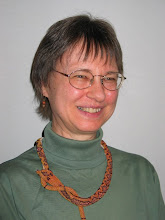 Saturday I immersed myself in bead matters as the members of the Bead Society of Great Britain who had presented papers at the Bead & Beadwork Conference in Istanbul, Turkey in 2007 repeated their talks for fellow BSGB members who were not able to make it to Turkey. The talks were held in the John Peek Room of the Birmingham & Midlands Institute (at left), another lovely 19th century building.
Saturday I immersed myself in bead matters as the members of the Bead Society of Great Britain who had presented papers at the Bead & Beadwork Conference in Istanbul, Turkey in 2007 repeated their talks for fellow BSGB members who were not able to make it to Turkey. The talks were held in the John Peek Room of the Birmingham & Midlands Institute (at left), another lovely 19th century building.The lectures were all very interesting and the experience was made even better by the beadwork exhibits pertaining to the lectures that members set up on tables around the room.
Sarah Withers spoke on the Arkell Bead Collection at the Pitt Rivers Museum in Oxford. Stephany Tomalin gave a fun and informative talk on "Realistic Replicas, Ingenious Imitations and Fantastic Fakes: Collecting Brazen Copies in the World of Beads."
Along with her talk, Stephany set out an extensive collection of imitation and fake beads. This is only part of it.
Margaret Carey gave two interesting talks on puzzles in African beadwork, examining a 150 year old, beadwork headress described as being from the Nuer people of the Nilotic Sudan and , seven-sided, faceted beads worn by a terra cotta figure found in Mali. Unfortunately, I don't have permission to reproduce the museum photos that Magaret used, but--trust me--the Nuer headress that may be based on English judicial wigs was really neat.


Carole Morris spoke next on early 17th century English beadwork purses from the reign of Charles I. These purses were made with a two-needle right angle weave stitch, which Vera Grey has reproduced in a purse shown at the bottom of the photo at left. A close up is above.
I was next to speak on the subject of World War I, Turkish prisoner-of-war and Balkan beadwork. My talk concentrated on the snakes and how they were a  continuation of crochet (with or without beads) in the Ottoman Empire, the tradition of civilian prisoners making souvenirs to sell, the view of snakes as good luck symbols, and the characteristics of the World War I bead crochet snakes as opposed to the later, civilian-made snakes and the commercially-made, bead crochet snake jewelry.
continuation of crochet (with or without beads) in the Ottoman Empire, the tradition of civilian prisoners making souvenirs to sell, the view of snakes as good luck symbols, and the characteristics of the World War I bead crochet snakes as opposed to the later, civilian-made snakes and the commercially-made, bead crochet snake jewelry.
 continuation of crochet (with or without beads) in the Ottoman Empire, the tradition of civilian prisoners making souvenirs to sell, the view of snakes as good luck symbols, and the characteristics of the World War I bead crochet snakes as opposed to the later, civilian-made snakes and the commercially-made, bead crochet snake jewelry.
continuation of crochet (with or without beads) in the Ottoman Empire, the tradition of civilian prisoners making souvenirs to sell, the view of snakes as good luck symbols, and the characteristics of the World War I bead crochet snakes as opposed to the later, civilian-made snakes and the commercially-made, bead crochet snake jewelry.Photo above: A lovely example of a World War I, Turkish prisoner-of-war, green and black, beadwork snake exhibited by Lady Suzanne Warner.
Margaret Carey ended our day of presentations with a short talk on the history and manufacture of 'garden roller' beads at Zimbabwe.
The other fun part of the day was seeing the antique and new bead crochet items that BSGB members had brough for the exhibit. Here are some of the other items.
WWI, Turkish POW beadwork, bead crochet Muslim rosaries, and a civilian-made snake brought by Carole Morris.

More snakes brought by myself and Lady Warner, a civilian-made, blue, red, and white bead crochet necklace, and a WWI Turkish POW lizard brought by Carole Morris. There is also a black and brown, commercially-made snake necklace but it doesn't show on the black background.

Indian beadwork showing peacocks and the tree of life design brought by Carole Morris.

The bead crochet items brought by Marita Page included Muslim rosaries, antique pocket watch holders, WWI Turkish POW snakes, and new Turkish prisoner key holders, key chain, and Masallah birdies.
Don stayed for some of the lectures but while we were busy with bead matters, he also wandered around parts of Birmingham. One of the events he stumbled across was the Dragon boat race held on one of the canals.

We ended our day with a lovely meal at a French restaurant with some of our favorite BSBG members.

Left to right: Carole Morris, Graeme Morris, Stephany Tomalin, Margaret Carey, and me. Don is taking the photo.




No comments:
Post a Comment